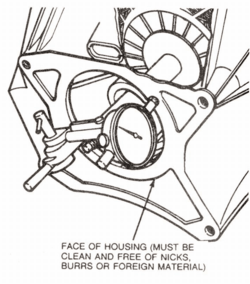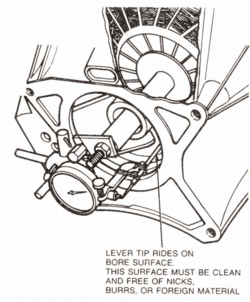FAQ
The following are some Frequently Asked Questions phoned into the Ford Performance "Techline." For specific inquiries about Ford Performance Parts, call us at (800) FORD788.
The 1996-2003 4.6 SOHC Mustangs use a 19-pound injector.
The 1993-95 Cobra Mustangs use a 24-pound injector.
The 1996-2001 Cobra Mustangs use a 24-pound injector.
The 2003 Cobra Mustangs use a 39-pound injector.
Note: See the FRPP catalog to determine if you need EV1 style or EV6 style injectors.
1981-2001 302 engines were built with a 50-ounce imbalance factor.
1969-97 351W engines were built with a 28-ounce imbalance factor.
1970-74 351C engines were built with a 28-ounce imbalance factor.
Note: Severe engine damage will result if you use the wrong flywheel or damper on your engine.
1986-95 Mustangs with a 5.0 and an automatic work well with 3.73 gears.
1996-2003 Mustangs with a 4.6 SOHC and a 5-speed work well with 3.73 gears.
1996-2003 Mustangs with a 4.6 SOHC and automatic work well with 4.10 gears.
1996-2001 Mustang Cobras with the 4.6 DOHC/5-speed work well with 3.73s.
2005-2012 Mustang GT works well with 3.73's.
Note: The above suggestions are general recommendations. Gear-ratio selections may change depending on modifications to your engine. For specific applications, call the FRPP "Techline" (800) FORD788* for professional advice.
The flywheel to crankshaft bolts must be hand-torqued to 75-85 ft./lbs. (302/351W) and 54-64 ft./lbs. (4.6L) The 10.5" pressure plate bolts must be torqued to 12-24 ft./lbs. and 11" pressure plate bolts to 33 ft./lbs. + 1/4 turn.
Be sure to use the alignment dowels in the flywheels. Pressure plate bolts and alignment dowels for the 10.5" clutch can be purchased using PN M-6397-A302. Pressure plate bolts N808969-S100 and alignment dowels D1FZ-6397-B are for the 11" pressure plate.
Evenly tighten bolts in a circular direction one turn at a time. Bellhousing alignment is crucial for proper clutch and transmission function.
Due to production tolerances of engine blocks and bellhousings, it is possible for the transmission centerline and crankshaft centerline to be misaligned. Misalignment can cause transmission gear wear, transmission jumping out of gear, driveline vibration, clutch pedal vibration, pilot bearing noise, release bearing noise or excessive clutch spin time. It may also damage the pilot bearing, transmission mainshaft bearing and clutch hub. It will also cause harsh shifting.
Before installing the bellhousing, check the block mounting surface and bellhousing surfaces for nicks, dents, paint debris, etc. These are some things that could affect the accuracy of your measurements.
The next step is checking bellhousing bore runout. You are checking to see if the bellhousing bore centerline is aligned with crankshaft centerline. Reposition the dial indicator in the bellhousing bore (as shown fig. 2). Rotate the crankshaft and mark down the readings. Maximum out of concentricity is .015. If the bore runout is out of spec. install appropriate offset dowels.
Offset alignment dowels can be purchased from Lakewood.
.007 PN 15950
.014 PN 15960
.021 PN 15970

